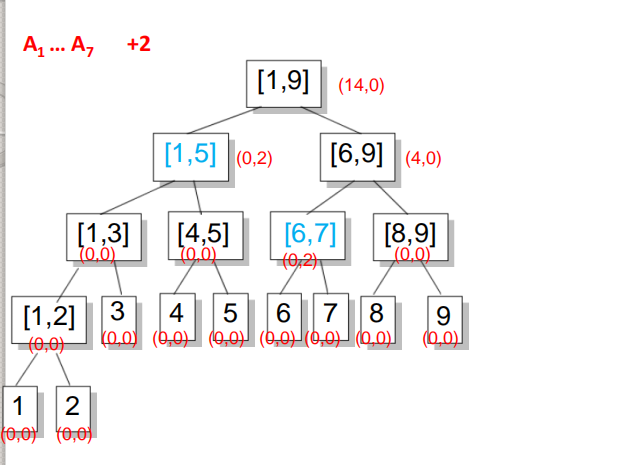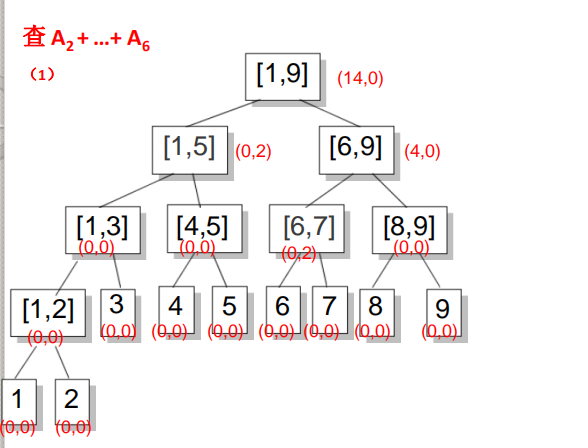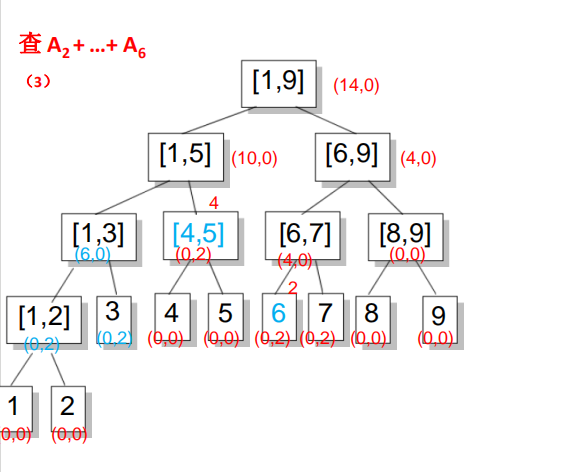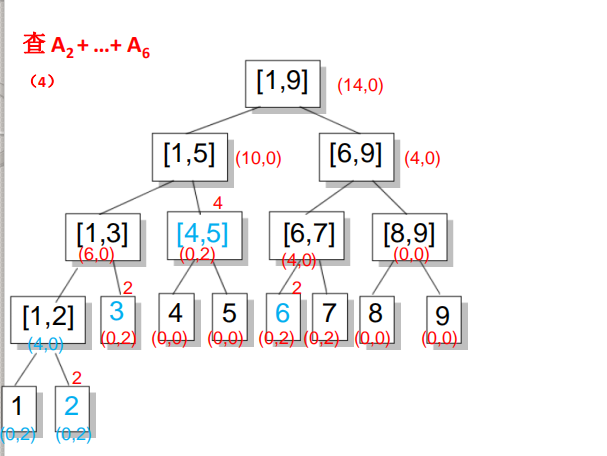POJ3368(Frequent values)--线段树
| 3368 | Accepted | 7312K | 1829MS | C++ | 6936B |
题意为给你一组数据,再给定一组区间,问你这个区间内出现次数最多的元素的次数是多少。
我还记得这题是学校校赛基础的题目,当时懵懵懂懂的用分治交了6次TLE。知道了线段树之后才后悔每更早的认识她。
一段区间内的多次出现的数的次数,在线段树查询中有以下几种情况
1.次数最多的都集中在某一结点的左区间内
2.次数最多的都集中在某一结点的有区间内
3.次数最多的在左右两边都有,这时maxCount ==左右两边的maxCount之和
在增加时,如果要加的区间正好覆盖一个节点,则增加其节点的Inc值,不再往下走,否则要更新nSum(加上本次增量),再将增量往下传。这样更新的复杂度就是O(log(n))在查询时,如果待查区间不是正好覆盖一个节点,就将节点的Inc往下带,然后将Inc代表的所有增量累加到nSum上后将Inc清0,接下来再往下查询。






1 /************************************************************************* 2 > File Name: poj3368rmq.cpp 3 > Author: YeGuoSheng 4 > Description: 5 > Created Time: 2019年07月11日 星期四 15时34分56秒 6 ************************************************************************/ 7 8 #include<iostream> 9 #include<stdio.h> 10 #include<cstring> 11 #include<cmath> 12 #include<vector> 13 #include<stack> 14 #include<map> 15 #include<set> 16 #include<list> 17 #include<queue> 18 #include<string> 19 #include<algorithm> 20 #include<iomanip> 21 using namespace std; 22 23 template <typename T> 24 struct node 25 { 26 int l; 27 int r;//左右区间端点 28 T value; 29 T add; 30 int lCount;//元素在左边的计数 31 int rCount;//元素在右边的计数 32 int maxCount;//总计出现的次数 33 int Len()const; 34 int Mid()const; 35 }; 36 37 template <typename T> 38 int node<T>::Mid()const 39 { 40 return (r + l )/ 2; 41 } 42 43 template<typename T> 44 int node<T>::Len()const 45 { 46 return (r - l ) +1; 47 } 48 49 template<typename T> 50 class IntervalTree 51 { 52 protected: 53 int n; 54 node<T>*tree; 55 public: 56 IntervalTree(int n); 57 ~IntervalTree(); 58 void BuildTree(int v,int l,int r); 59 void Add(int v,int l,int r,T m); 60 T Query(int v,int l,int r); 61 void Insert(int v,int i,T value); 62 void BuildCount(int v,int l,int r); 63 int FindIndexInTree(int v,int y);//在数组下标为u的在树中的下标 64 }; 65 66 template<typename T> 67 IntervalTree<T>::IntervalTree(int n) 68 { 69 this->n = n; 70 tree = new node<T>[4*n]; 71 } 72 73 template<typename T> 74 IntervalTree<T>::~IntervalTree() 75 { 76 delete []tree; 77 } 78 79 template<typename T> 80 void IntervalTree<T>::BuildTree(int v ,int l,int r) 81 { 82 tree[v].l =l; 83 tree[v].r = r; 84 tree[v].add = 0; 85 tree[v].value = 0; 86 if(l == r)//相等 87 { 88 tree[v].lCount =tree[v].rCount = tree[v].maxCount = 1; 89 return ; 90 } 91 int mid =(l + r) /2;//二分 92 BuildTree(v* 2+1,l,mid); 93 BuildTree(v*2+2,mid+1,r); 94 tree[v].value = tree[2*v+1].value + tree[2*v+2].value; 95 } 96 97 98 template<typename T> 99 int IntervalTree<T>::FindIndexInTree(int v,int u) 100 { 101 if( tree[v].l == u && tree[v].r == u) 102 { 103 return v; 104 } 105 else 106 { 107 int mid = (tree[v].l + tree[v].r) / 2; 108 if(u <= mid) 109 { 110 FindIndexInTree(v * 2+1,u); 111 } 112 else 113 { 114 FindIndexInTree(v * 2+2,u); 115 } 116 } 117 } 118 119 template<typename T> 120 void IntervalTree<T>::BuildCount(int v,int l ,int r) 121 { 122 tree[v].l = l; 123 tree[v].r = r; 124 if(l == r) 125 { 126 tree[v].lCount = tree[v].rCount =tree[v].maxCount = 1; 127 return ; 128 } 129 int mid = (l + r )/ 2; 130 BuildCount(2* v+ 1,l,mid); 131 BuildCount(2*v +2,mid+1,r); 132 int repeat = 0; 133 int leftIndex = FindIndexInTree(v,tree[2*v+1].r); 134 int rightIndex = FindIndexInTree(v,tree[2*v+2].l); 135 if(tree[leftIndex].value == tree[rightIndex].value) 136 { 137 repeat = tree[2 * v +1].rCount + tree[2*v +2].lCount; 138 } 139 else 140 { 141 repeat = 0; 142 } 143 tree[v].maxCount = max( repeat,max( tree[2*v+1].maxCount, tree[2*v+2].maxCount) ); 144 tree[v].lCount = tree[2*v+1].lCount; 145 if(tree[2*v + 1].lCount == mid - l + 1 && tree[leftIndex].value==tree[rightIndex].value) 146 { 147 tree[v].lCount += tree[2*v +2].lCount; 148 } 149 if(tree[2*v + 2].rCount == r- mid && tree[rightIndex].value==tree[leftIndex].value) 150 { 151 tree[v].rCount += tree[2*v +1].rCount; 152 } 153 } 154 template<typename T> 155 void IntervalTree<T>::Add(int v,int l,int r,T m)//区间的更新操作 156 { 157 if(tree[v].l == l && tree[v].r == r) 158 { 159 tree[v].add +=m; 160 return ; 161 } 162 tree[v].value += m * (r- l +1); 163 int mid = (tree[v].l + tree[v].r) /2; 164 if( r<= mid) 165 { 166 Add(v *2 +1,l,r,m); 167 } 168 else 169 { 170 if(l > mid) 171 { 172 Add(v *2 +2,l,r,m); 173 } 174 else 175 { 176 Add(v *2 +1,l,mid,m); 177 Add(v*2+2,mid+1,r,m); 178 } 179 180 } 181 182 } 183 template<typename T> 184 T IntervalTree<T>::Query(int v,int l,int r)//对根结点为v,查询区间l 到 r 185 { 186 if(tree[v].l == l && tree[v].r == r) 187 { 188 return tree[v].value +(tree[v].r - tree[v].l +1) * tree[v].add; 189 } 190 if(tree[v].add != 0) 191 { 192 tree[v].value += (tree[v].r - tree[v].l +1) * tree[v].add; 193 Add( v * 2 +1,tree[v].l,tree[v].Mid(),tree[v].add); 194 Add( v * 2 +2,tree[v].Mid()+1,tree[v].r,tree[v].add); 195 tree[v].add = 0; 196 } 197 int mid = tree[v].Mid(); 198 if( r <= mid) 199 { 200 return Query(v * 2 +1,l,r); 201 } 202 else 203 { 204 if( l > mid) 205 { 206 return Query(v * 2+ 2,l ,r); 207 } 208 else 209 { 210 return Query(v * 2+1,l,mid) + Query(v* 2+2,mid+1,r); 211 } 212 } 213 } 214 215 template<typename T> 216 void IntervalTree<T>::Insert(int r,int i,T value) 217 { 218 if(tree[r].l == i && tree[r].r == i) 219 { 220 tree[r].value= value; 221 return ; 222 } 223 tree[r].value += value; 224 if(i <= tree[r].Mid()) 225 { 226 Insert(2*r+1,i,value); 227 } 228 else 229 { 230 Insert(2 * r+ 2,i,value); 231 } 232 } 233 234 int main() 235 { 236 int n = 0; 237 while(cin>>n && n > 0) 238 { 239 IntervalTree<int> it(n); 240 it.BuildTree(0,0,n-1); 241 int q = 0; 242 scanf("%d",&q); 243 for(int i = 0; i< n;i++) 244 { 245 int num = 0; 246 scanf("%d",&num); 247 it.Insert(0,i,num); 248 } 249 it.BuildCount(0,0,n-1); 250 for(int i =0 ;i < q;i++) 251 { 252 int x,y; 253 cin>>x>>y; 254 cout<<it.Query(0,x-1,y-1)<<endl; 255 } 256 } 257 return 0; 258 }
----------------------------------------------------------------------------------------------------------------转载请说明出处----------------------------------------------------------------------------------------------------------------------
你要做一个不动声色的大人了。不准情绪化,不准偷偷想念,不准回头看。去过自己另外的生活。你要听话,不是所有的鱼都会生活在同一片海里。
————————村上春树




